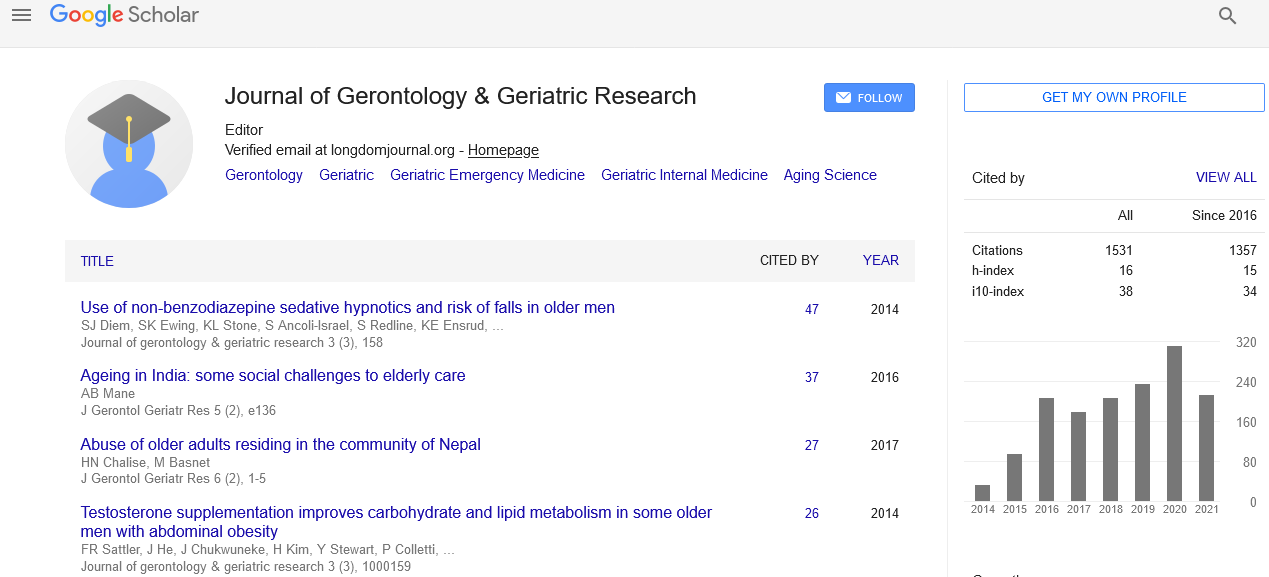PMC/PubMed Indexed Articles
Indexed In
- Open J Gate
- Genamics JournalSeek
- SafetyLit
- RefSeek
- Hamdard University
- EBSCO A-Z
- OCLC- WorldCat
- Publons
- Geneva Foundation for Medical Education and Research
- Euro Pub
- Google Scholar
Useful Links
Share This Page
Journal Flyer

Open Access Journals
- Agri and Aquaculture
- Biochemistry
- Bioinformatics & Systems Biology
- Business & Management
- Chemistry
- Clinical Sciences
- Engineering
- Food & Nutrition
- General Science
- Genetics & Molecular Biology
- Immunology & Microbiology
- Medical Sciences
- Neuroscience & Psychology
- Nursing & Health Care
- Pharmaceutical Sciences
Strategies for communicating older people with disability
International Conference on Geriatrics & Gerontology
July 08-10, 2014 DoubleTree by Hilton Hotel Chicago-North Shore Conference Center, USA
Karima Elshamy
Accepted Abstracts: J Gerontol Geriat Res
Abstract:
Introduction: Communication is the cohesive force in every human culture and a dominant influence in the personal life of everyone. Through the communication process, people exchange information, thoughts, ideas, and emotions. Communication is the key factor to facilitate interpersonal helping and the changes in direct‐practice activities and it can be seen as a tool to integrate people into society. However, barriers in communication can often occur due to factors relating to physical, cultural, experiential, emotional, linguistic, and gender differences. These barriers can have a negative effect on vulnerable groups such as older people. Physiological, psychological and emotional changes in the elderly often highlight the barriers to communication. This would put them at risk in terms of communicating their thoughts and needs to their families, friends, community and the people who provide services such as healthcare workers. Aged and community care workers need to have a thorough understanding of the aging process and how this affects communication. This will enable them to better understand their clients, develop essential skills for positive communication with older people and bridge the communication gap to better deliver services. Aged and community care workers can adopt these positive communication strategies to assist them in delivering effective and appropriate care services. Aim of presentation: This presentation will focus on the following: 1. Definition and process of communication 2. Definition of aging 3. Some behavioral signs of age‐related hearing loss in adults 4. Some behavioral signs of age‐related vision loss in adults 5. Communication techniques for hearing impaired older people 6. Communication techniques for vision impaired older people 7. Communication techniques for older people with aphasia 8. Communication techniques for older people with dementia 9. Communication techniques for culturally and linguistically diverse older population
Biography :
Karima Elshamy has a Doctorate degree in Nursing Science from Cairo University, Egypt (DNSc). She is a Prof. of Medical Surgical Nursing and Head of Gerontological Nursing Department, Faculty of Nursing, Mansoura University, Egypt. She represented AORTIC Nursing of North Africa since 2009 ? 2011, and from 2011 - 2013 she was AORTIC Vice President of Oncology Nursing, and now she is AORTIC Vice President of North Africa. She is a member of the Editorial Board of the Journal of Cancer Policy. She is Accreditation Reviewer in Ministry of Health, Egypt. She is a founder and executive Director of the Egyptian Society for Promotion of Women?s Health.


